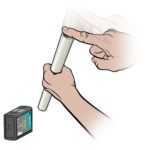Experiments
Here are experiments our science specialists have selected to support the IB* topic.

Standing Waves on a String
Experiment #3 from Advanced Physics with Vernier — Beyond Mechanics
In this experiment, you will
- Adjust the frequency of the driver so that the string vibrates in the fundamental mode.
- Set up other standing wave patterns on the string.
- Relate the frequency of the various harmonics to that of the fundamental mode of vibration.
- Describe the terms amplitude, frequency, wavelength, node, and antinode as they relate to vibrating strings.
- Determine the velocity of waves in the string.
- Relate wave velocity to the tension of the string and its linear density.

Standing Waves in a Column of Air
Experiment #4 from Advanced Physics with Vernier — Beyond Mechanics
In this experiment, you will
- Set up standing wave patterns in a column of air in open-end and closed-end tubes.
- Determine the relationship between tube length and wavelength for these standing waves.
- Use transverse wave patterns to describe the nodes and antinodes that occur in a column of air in open-end and closed-end tubes.
- Determine the speed of sound in air.
- Educational Standard
- International Baccalaureate (IB)
- Subject
- Physics
- Section
- Core
- Topic
- 4. Waves
* The IB Diploma Program is an official program of the International Baccalaureate Organization (IBO) which authorizes schools to offer it. The material available here has been developed independently of the IBO and is not endorsed by it.
